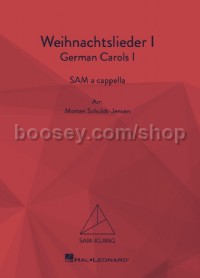Weihnachtslieder I/German Carols I (Choral Vocal Score)
Weihnachtslieder I/German Carols I (Choral Vocal Score)
Bulk Discounts Available
* Estimated price converted from UK retail price
In many parts of the world, Advent and Christmas carols have become part of the standard repertoire of popular songs, and this tradition has also produced a large number of such songs in German-speaking countries. These include not only folk songs, some of unknown origin, but also art songs in various styles, as well as movements from popular classical Christmas works. This diversity is reflected in this first volume of German-language Christmas carols, which brings together carols from a broad range of eras, origins and styles. For example, in addition to the chorale Brich an, du schönes Morgenlicht from Bach’s ‘Christmas Oratorio’, there are two old Bohemian carols – Freu’ dich, Erd’ und Sternenzelt and Kommet, ihr Hirten – familiar to many German choirs in the traditional arrangements by Carl Riedel. They appear here in a more modern guise, the former very accessible, the latter a little more demanding, but certainly a worthwhile challenge for any choir! The classic O du fröhliche brings us back to a more traditional setting, and the remaining piece in this collection, Johannes Eccard’s beautiful Übers Gebirg Maria geht, will enhance any Advent or Christmas programme.
Editorial note: Some pieces in this volume feature brackets that comprise ‘ternary cells’ – cells of three beats – of differing lengths. Before the mid-17th century in the stile antico, it was common for each vocal line to have an independent stress pattern: a sequence of binary or ternary accentuations guided by the declamation of the text in order to give life to each voice. Despite the non-legato of the individual single layer – created by elements including the musical articulation, the (hairpin) phrasing of the ternary cells and a natural text declamation – the constant displacement of stresses between the voices provides an overall feeling of flow right through to the next cadence, at which point the ‘cells’ come together. Certain characteristics of this style, such as hemiolas and cadential conventions, survived in the following centuries and can be found in the music of Haydn, Mozart, Schubert and Brahms, and even later composers with an affinity for vocal polyphony. The voices in these SAM arrangements take on more than just their own polyphonic role, occasionally switching between parts to maintain the integrity of the original music. Despite the initial challenges the removal of a part would suggest, choirs will reap the benefits of replicating the contrast and vitality of the original inner textural phrasing, and although the brackets and absence of normal bar lines may seem very different from a conventional edition, we are confident that any initial difficulties should be quickly overcome, and that the resulting quality and transparency of performance will be considerably more satisfying for both singer and listener.




